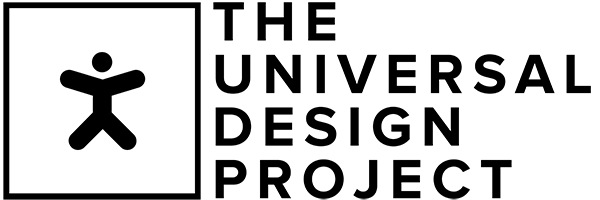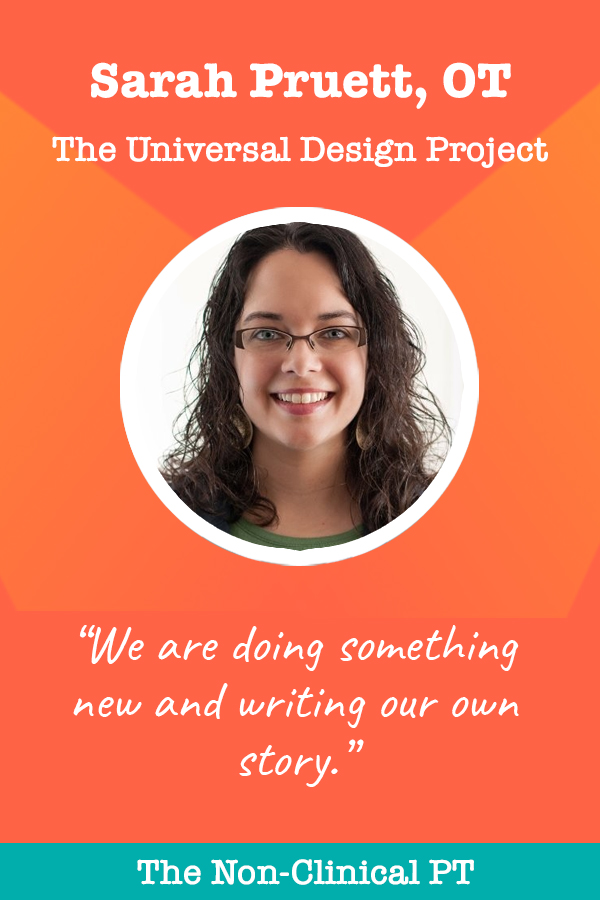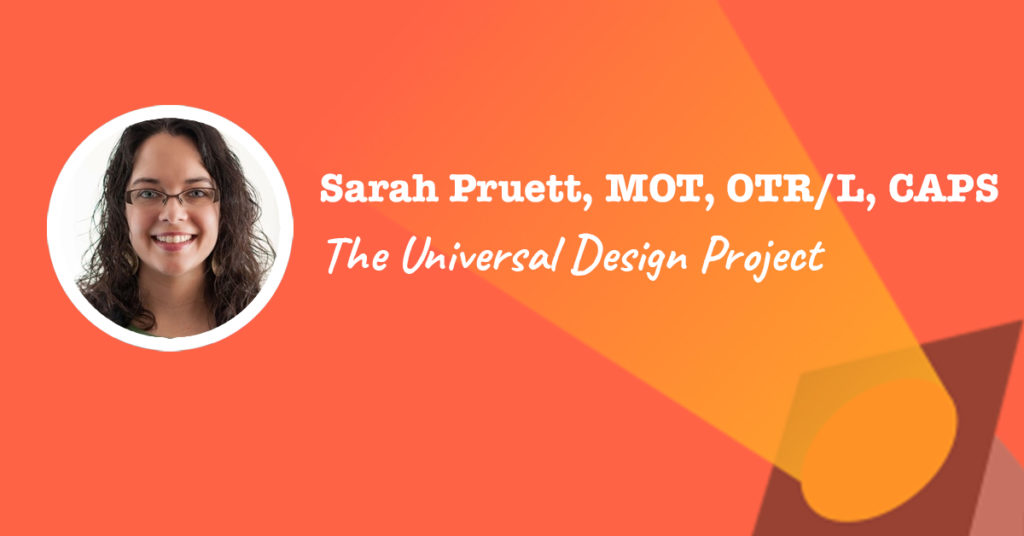This post may contain affiliate links or codes. This won’t increase your cost, but it helps keep TNCPT alive, and free of annoying ads! Thank you for your support. 🙂
What is your full name and title at your current job?
Sarah Coffey Pruett and I’m an OT and Program Director with The Universal Design Project.

Where did you go to OT school, and what year did you graduate?
I went to James Madison University and graduated with a master’s degree in occupational therapy in 2008.
What did you do when you first finished school, and for how long?
When I first finished school, I was planning a wedding and hadn’t yet married my husband. He had just gotten accepted to grad school to get his master’s degre in therapeutic recreation in Greensboro, NC.
I spent some time to studying for the NBCOT exam and then took my first job at [now] Cone Health in Greensboro working on the Inpatient Rehab Unit (IRU). I was on the Spinal Cord Injury (SCI) team and treated individuals who had SCIs, back surgeries, deconditioning, cancer, and amputations.
I stayed in this job for about three years until my husband finished school and he needed to do his internship. He wanted to go out to Colorado to work with The Adaptive Sports Center and I was excited to go with him!
How did you get into the universal design space?
While we were in Colorado, I decided to do some volunteer work for the same organization and took some time to evaluate the lodging facilities in their mountain town so people could understand what accessible lodging options were available. T
his town is not your typical town with well-known hotels. Most were run by small families or were privately owned, so it was difficult for someone coming from out of town to know what their room would look like. I did video tours and did lots of measurements of doorways and bathrooms. It was a lot of fun to see the different places to stay in that town, plus provide a resource for people that needed specific information for lodging while visiting the town.
I’ve always really enjoyed the environmental modification niche of OT. When I was in my first job I took a course on home modifications and thought it would be really neat to do that full time, but it just didn’t seem like the right time then.
At what point did you realize you wanted to do this as your long-term gig?
After my husband, Scott, finished his internship for his Master’s, we had some flexibility on what was next. We both knew we had a unique perspective professionally and personally and decided we could actually combine his skills and my skills to start our own business. I’d focus on home accessibility, and he’d work on program design.
We both liked the idea of designing for a wide range of people and thought focusing on universal design would be a good fit.
We both understand disability, as Scott has had three different spinal cord injuries. The first in 1999 at the C6-7 level. He has had an SCI for 20+ years and has navigated homes and communities in a wheelchair. We knew things could be better, and we wanted to make a difference for others.

What are you doing these days?
We have a 14-month-old daughter; between her and the organization, I’m currently not treating in a clinical capacity.
Did you get any special certifications or training along the way to help you get into your current role?
I knew if I was going to be consulting with homeowners and builders, I needed to understand different professions in the building industry. I started by taking the Certified Aging in Place Specialist class through the National Association of Homebuilders. It was a three-day course and I got my feet wet, but I also learned how much builders were learning about disability (not much). It really helped me realize that we all can’t be an expert at everything and my role collaborating with them was just as important as them collaborating with me.
When did you start your business?
We started our consulting business in 2012 then moved it to a nonprofit in 2016. The business has gone through quite a bit of change over the years and we’ve learned so much in the process.
Where did you get the idea for your The Universal Design Project?
As an OT, I knew that there were so many people living in homes that just didn’t fit their functional needs. People have to pick and choose what areas of the home they can successfully live in or even access because of areas are just not accessible to them. Finances are often a huge barrier for modifications, plus the homes most people live in are just not welcoming to illness or injury.
Many were going home from the hospital having to set up a bed in their living room and figure out how to wash up in the kitchen or a half-bath on the first floor because they couldn’t reach all the bedrooms on the second floor.
When my husband was first injured, his mom had to change their living room into a bedroom and bathroom so he’d have a place to go when he got back from rehab after his spinal cord injury.
Between my experiences professionally and personally, I knew that the current way homes were being designed was not working for people living with a variety of health conditions.
Not only that, but the inaccessibility of homes impacts friends and family too! It’s difficult for people to visit or stay with others if the home they are going to has steps to get in, and a tiny bathroom on the main floor.
What is your business, and what types of products or services do you offer?
In our consulting business, I go into people’s homes and do an evaluation of their space and give them recommendations on what could make it more functional. I then collaborate with builders to make the changes.
It could be as simple as widening doorways or getting additional equipment for making bathing safer—but sometimes the jobs were bigger, like taking down walls or renovating a bathroom.
That is ambitious! I’m sure there have been some challenges…
Yes, there were. We quickly realized that most homeowners didn’t have the funds to make these changes (especially if dealing with medical bills or on a fixed income), which made it difficult for them to pay me for the consult—not to mention the expense of hiring a builder to do the work.
I also ran into some confusion with those who work in the building industry about why an occupational therapist should be part of the home modification process.
I was:
- Having to explain what OT was
- Having to explain the need for me to be part of the team.
Many contractors had taken classes on aging in place and thus didn’t think I was needed.
I imagine you had to change up your business plan, then?
With those barriers in mind, we decided to take a different direction with our business in 2016. We switched to a nonprofit to find different sources of funding through grants and fundraising. We also wanted to work on the design of new homes.
We believe they need to be designed collaboratively, and we needed designers, healthcare professionals, and people with first-hand experience with disability giving input onto new housing plans.
Involving all of those people is pretty costly and trying to do the same kind of work as consultants seemed like a never-ending uphill battle.
What are some words of wisdom you can share about this process?
Starting a new nonprofit has been challenging and it’s taken a long time to figure out how to make it work. We are working toward collaboratively designing home plans that can be purchased online that are universally accessible and affordable.
We know we can’t 100% meet everyone’s needs, but we can put options out there that are way more functional for a wide variety of people. We feel like our process is unique because we put a heavy emphasis on
- The input of those who experience disability every day and
- Collaboration between a professional team of healthcare providers and architects
How have people reacted to your unconventional career path?
People will often tell us that it’s a great idea and there are so many people who will benefit; however, they don’t see all the details that have to fall into place for it to work.
Consumers, builders, designers, and the general public have to see the value in designing everyday homes that are functional and can look like every other home on the block.
We’ve concluded that people really have to experience universal design in-person to truly understand it. If they don’t, people will think that we are just designing for people who have disabilities and that universal design isn’t useful for them.
It sounds more like a movement than a business on some level.
We often say we are working to impact people who are “affected by disability” which includes friends, family, and neighbors of those who have a disability.
I know I’m preaching to the choir here, but the definition of “disability” is so much broader than people think. It’s not just people who use wheelchairs.
We have to field a lot of questions and continually do education for people to really understand what we’re doing. That’s been the best way to help with some of the positive and negative reactions to our decisions.
I’ve often been asked if I’ll get back to doing OT again, and I have to explain that what I am doing directly relates to the field of OT, it’s just not in a traditional work setting that many think about.
What’s a typical day or week in the life like for you? What types of tasks and responsibilities fill your time?
As a two-person team with several volunteers, we are doing something different every day. It’s a challenge to manage programs, volunteers, network, work on marketing/sales, and keep up with emails!
We rely a lot on students and volunteers to help move our work forward.
What are some of the challenges of your role?
The big challenge is that we are doing something new and writing our own path. This model of collaboration isn’t common, and there isn’t a rulebook to follow or a set our process to put into place.
There’s a lot of trial and error with using ideas from other areas of practice to find an approach that works well.
How do you think working as an OT prepared you for this role?
Definitely having a broad knowledge of disabilities and working with people’s families has been helpful.
Not only are we designing homes for people to be independent, but often their families are assisting as well—and design needs to support that.
Working as an OT in the hospital system has also given me insight into barriers people face at discharge, specifically related to their home environment.
Many have to go home with temporary modifications, while others unfortunately had to move elsewhere because their current home situation isn’t safe.
Individuals going through a health crisis shouldn’t have to worry about their home situation while worrying about medical bills and getting better.
What type of person do you think would do well in your role?
A self-starter and curious learner. It’s also important to be okay with changing directions and trying things multiple times before finding something that works.
When forging our own path, it’s helpful to be able to dream big, plus be very detail-oriented. I am definitely not all of these characteristics, and so it’s been helpful to partner with my husband to spread the load.
We have also had to research and learn new things as we did not have all the knowledge needed to go this path from our previous schooling.
Do you work remotely or on-site?
We work remotely and use a project management system called Basecamp. Our volunteers are based across the US and the world.
When we begin to bring architects on board we will also work remotely with them. This is the easiest way to get a variety of people at the table while expanding our reach geographically.
Does your organization hire PT, OT, or SLP professionals into non-clinical roles?
Right now, our organization isn’t hiring—but we hope to in the future. We are currently looking for volunteers to be Design Advisors with our organization.
As our organization’s small design team works on new homes, we share them with a group of people who understand disability as a way of ensuring that no important detail is overlooked. This group is composed of healthcare professionals as well as individuals with disabilities.
We also are looking for people who have direct experience caring for a loved one, as they understand the daily needs of someone with a health condition, illness, or injury. Because we are a remote business, we are able to have volunteers participate from anywhere. Learn more about being a Design Advisor here: https://universaldesign.org/volunteer
What does your volunteer team look like at The Universal Design Project?
We have a small team of health professionals volunteering with our organization as part of our design team. We evaluate plans to make sure a wide variety of needs are accounted for. These three ladies have paved their way as non-clinical OT professionals as well and have similar mindsets about universal design and how it benefits communities. I also really appreciate their input as our knowledge combined together helps cover many areas of practice and fills in gaps of knowledge.
Tiffany Dill:
Tiffany is the owner of Blue Day 2 Designs, has a BA in Communications, a Masters of Public Health, and is a Doctor of Occupational Therapy.
Living with a hearing impairment throughout life has challenged Tiffany to seek new routes and adventures within her environments, particularly in large social settings. Her passion lies deep in helping others discover new ways to face their challenges. She has experience in various clinical settings and personally understands the need to live safely and independently for work, home, and play.
Nichole Kain:
Nicole is the owner of The Home and Place Project, has a BSc in Occupational Therapy, an MA in Gerontology, and a graduate certificate in Community Planning.
Using cross-disciplinary skills and a deep appreciation for the power of place and the importance of personal choice, Nichole helps create communities that enable people to stay in the home of their choice as they age. Combined with her deep passion for beautiful and thoughtful home design, she is a powerful advocate for cohesive places that promote healthy aging, intergenerational connection, and a thriving community.
Meaghan Walls:
Meaghan is the president & CEO of Assistology, has a BS in Mathematics, an MS in Bioengineering, and is a certified Assistive Technology Professional. She is not a therapist, but a therapist could pursue a specialization in AT and focus in a universal design type career to do similar things that she does.
As an engineer, Meaghan is especially passionate about creating ways to help individuals increase their participation in activities that improve functional abilities for daily living and obtain access to environments and activities that improve their quality of life. She works to take design beyond minimum requirements to incorporate the human experience throughout design processes.
What would you recommend to someone who is considering going into a role like yours?
It’s helpful to have a support system and understand that even though the need is clearly there, it doesn’t mean the path to execution is easy. Understanding the market and the stakeholders are important; however, some of that knowledge really can’t be learned until you dig your heels in and start making connections.
Thanks for your insight, Sarah!
Want to be an entrepreneur?
Learn to build, grow, and monetize a blog based on your existing rehab experience and skills!





